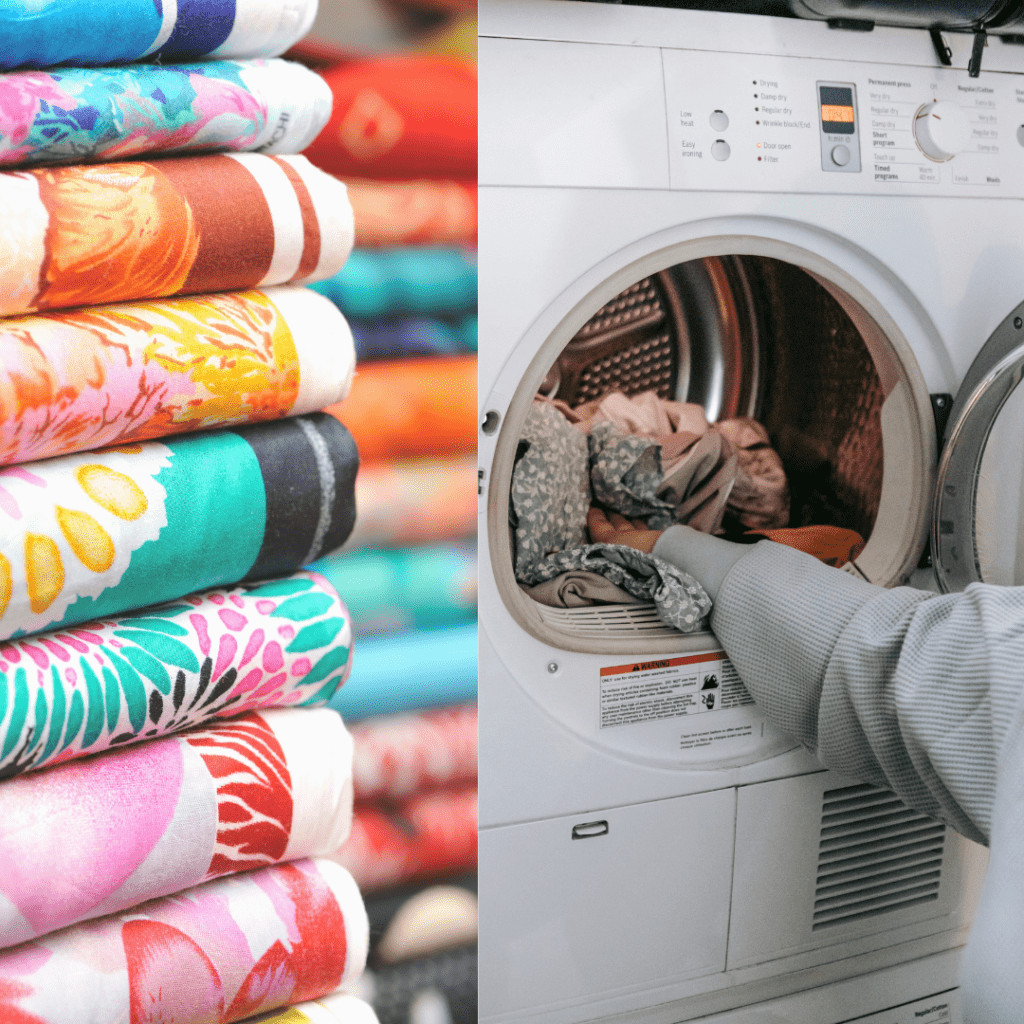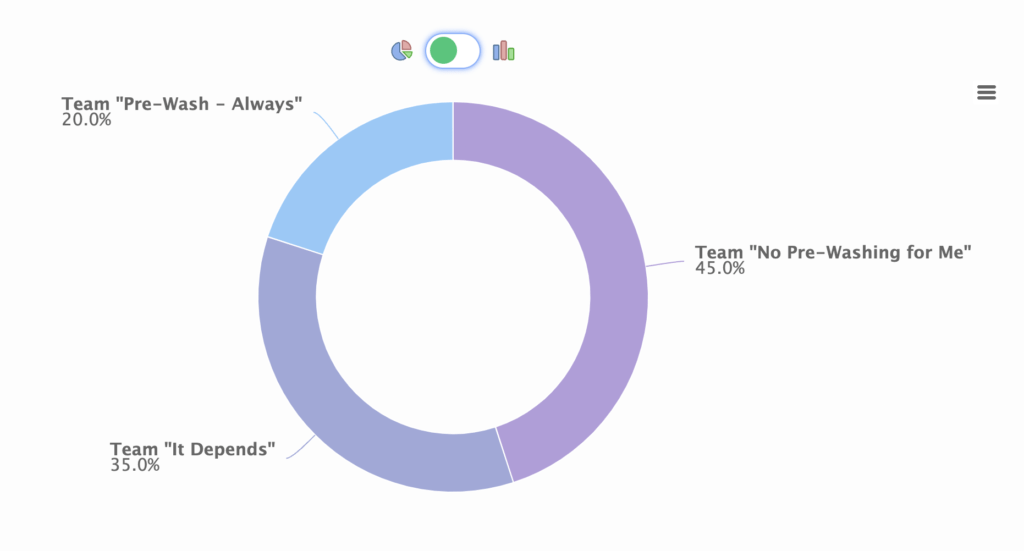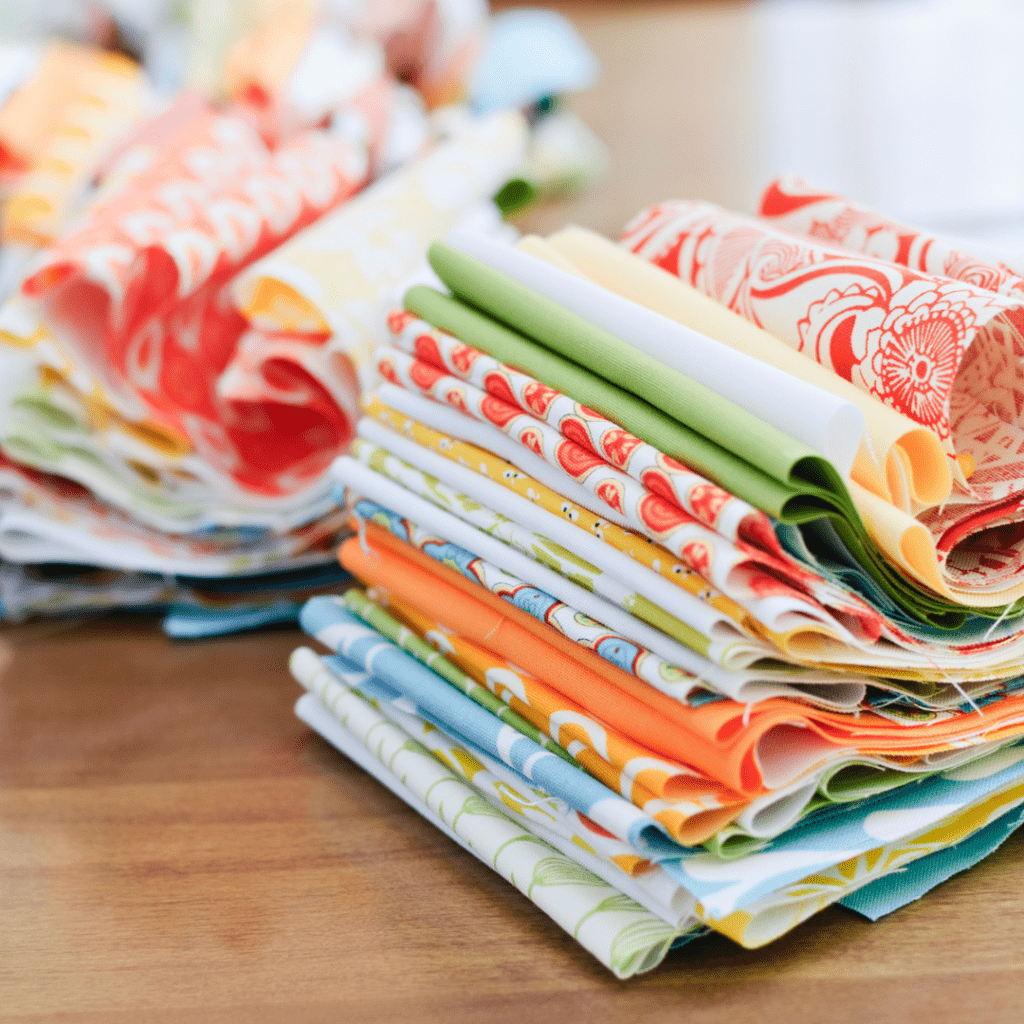Written by Deb Messina, Quiltblox.com

If there was one question I’ve been asked – more than any other in all the years I’ve been in business – it’s “should I pre-wash my fabric before I use it? I thought it would be interesting to survey how my customers and followers feel about this sometimes polarizing question. More about the results of that survey in a minute.
First – let’s take a look at why we learned to pre-wash fabrics in the first place.
IN THE BEGINNING
When I first started quilting in the 1970s (yikes!) we bought cloth from the fabric store or the fabric section of a department store. The fabric we had to choose from was a cotton-poly blend or a cotton “calico” – a print with a small all-over (usually floral) design.
- There were no 100% cotton quilting fabrics, batiks, or hand-dyed fabrics.
- There were no dedicated/stand-alone quilt shops.
- The dyes used for cotton fabrics were prone to bleeding – nearly all colors – not just the reds, dark blues, and blacks.
- Cotton fabrics had a low thread count and were used more for apparel than for quilting. The looser weave of the fabric meant more fabric shrinkage.
- Pre-washing was necessary to deal with the bleeding and shrinkage issues before the fabrics were used for sewing.
WHAT CHANGED
Since the mid-1970s quilting has enjoyed a resurgence and fabric manufacturers began to take notice. As quilters, we started to see the introduction of higher quality cotton “greige goods” – the base fabric that is printed to make modern, commercial print, batik, and hand-dyed fabrics.
- High-quality 100% cotton fabrics are readily available.
- The weave of cotton fabric is both finer and tighter – reducing (but not eliminating) overall shrinkage.
- Commercial fabric dyes have become more permanent – greatly reducing (but not eliminating) issues with bleeding.
Now we enjoy a wide variety of quality cotton fabrics for use in our quilting, sewing, and art projects. Has that changed how you prepare your fabrics for quilting/sewing?
THE SURVEY RESULTS
I know you’ve been waiting for the results – what team are you on?
Do You Pre-Wash Your Quilting Fabric? Are You:
- Team: “Pre-Wash – Always”
- Team: “It Depends”
- Team: “No Pre-Washing for Me”

I found the results of the survey interesting. Several of those that answered the survey had very strong reasons for their preference – and sent me emails to let me know the reasons for their “Team” choice. I love that!
In reality – there are no wrong answers – just personal preference and comfort level. If the process you are using (or not) is working for you – go for it.
I’ll BET YOU’RE WONDERING
I haven’t yet told you which team I’m on. Drum roll please … I’m definitely on Team “It Depends” – I have some rules (that work for me) – and it varies by fabric type and what I plan to use the fabric for.
MY RULES
The following are my rules – they haven’t failed me yet. If what you are doing is working for you – no need to change things up. If not – I do hope you’ll find something useful here to help you prepare your fabric for quilting and avoid the issues of bleed and shrinkage.
NO MIXING
My number 1 rule: I know that some of you may mix washed and unwashed fabrics in the same quilt – without negative results – but my experience hasn’t been great when I do that.
Because of that – I never mix pre-washed and unwashed fabrics in the same quilt. It’s an issue of shrinkage. Pre-washed fabrics and those that are unwashed will shrink at different rates – resulting in a quilt that looks like it’s trying to pull itself apart after it’s been through a wash cycle. Do not ask me how I learned that painful lesson. Bleeding can still happen – so I test for that ahead of time.
TEST FOR BLEED:
This is particularly important if I’m not going to pre-wash my fabrics. I cut a small square swatch (6” x 6”) of each piece of (unwashed) yardage I plan to use in my quilt and the same number and size of plain white fabric swatches. I soak each quilting fabric (separately) along with a piece of plain white fabric in bowls of hot water to see if any bleeding shows up.

If I’m still not certain – I will then take those pairs of fabric swatches (stacking each pair together) – and iron them dry with a hot iron. If the dye transfers to the white fabric, I will treat that fabric with Retayne to fix the dye into the fabric. One treatment for each fabric is all that’s necessary.
TEST FOR SHRINKAGE:
This same test will also tell me if one or more of the fabrics shrinks more (or less) than the others. Measure each swatch after it’s been soaked in hot water and then allowed to dry. Should one or more shrink quite differently from the rest – I reconsider using that fabric in the quilt and switch it for something else.
IF I DO PRE-WASH:
SECURE THE RAW EDGES:
Have you ever washed a cut piece of yardage and then opened the washer to find a clean – but mangled knot of fabric encased in a snarl of unraveled threads? Me too.
To prevent this issue, I roll the raw edge over on each cut end of the yardage and sew a basting stitch (very long stitch length) from one selvage edge to the other selvage edge.
Why? This helps to eliminate raveling and distorting the orientation of the threads that make up the fabric. A long basting stitch is quick to do – and easy to remove after the fabrics are washed and dried.
PRESS AND STABILIZE:
I always press the pre-washed fabric before using it. I use a light mist of Best Press and a hot iron to remove any wrinkles and to add a back a bit of body that was removed in the washing process. This body makes the fabric easier to handle, the cuts more accurate and the pieces easier to match up. I never skip this important step.
FABRIC PREP BY FABRIC TYPE
PRE-CUTS:
Absolutely not. I’m talking about all those fun precut fabric bundles (Charms Pack, Layer Cakes, Jelly Rolls, etc.) that come perfectly cut and ready to use from the fabric manufacturer.

All the cut edges mean that every thread is “free floating” and can unravel or pull apart with the action of the washing machine. This can happen even with hand-washing the fabric.
If I’m using precuts in a quilt top – I don’t pre-wash any of the yardages I’m using in the quilt top either. I want everything to shrink the same – so I wait to wash it until it’s a completed quilt.
COMMERCIALLY PRINTED QUILTING FABRICS:
“Prints” – are just that – printed on one side of the fabric in continuous lengths sometimes hundreds of yards long. They are then cut to length and double folded onto bolts – with the printed side out. They have an obvious “Front” and “Back” side.
The commercial dies used in printed fabrics are normally very stable and chemical based rather than vegetable based. This reduces the issue of bleeding. The tight weave of this fabric is also more stable than fabrics made back in the day. This tighter weave means far less shrinkage.
If my commercially printed fabrics pass my bleeding and shrinkage tests, then no, I don’t usually pre-wash these fabrics.
If one or more of the fabrics I’m using – fail the bleed test, I’ll treat them with Retayne – following the manufacturers’ directions, to pre-wash that fabric.
Please note – only use Retayne to pre-wash the fabric. Don’t use Retayne to try and remove any bleed that occurs after your quilt is completed.
COMMERCIAL QUILTING FABRICS – BATIKS:
Batiks are made using a wax resist and dye bath process. They have already been cleaned to remove the wax after the dying process.
That being said – if I am using batiks in an art quilt that won’t be washed – I don’t wash them.
If I’m using batik yardage in a quilt – I do prewash them using Retayne (a color fixative). Retayne locks (or fixes) the dye into the fibers of the fabric – and prevents future bleeding.
As noted in the section on printed commercial fabrics: Only use Retayne to pre-wash the fabric. Don’t use Retayne to try and remove any bleed that occurs after your quilt is completed.
HAND-DYED FABRICS:
Hand-dyed fabrics are 100% cotton fabrics that have been dyed in small batches. Unlike batiks – no wax is used as a resist to create a pattern. Similar to batiks – the dyes create a saturated effect on both sides of the fabric – meaning there is no “wrong” side to the fabric.
The fabric can only “absorb” so much of the dye – any excess dye remains loosely attached or floating. The use of Synthrapol and hot water as a pre-wash after dyeing the fabric will remove the excess dye particles from the fabric.
I always use Synthrapol to pre-wash my hand-dyed fabrics before I use them.
UPCYCLED FABRICS
The use of “upcycled” fabrics is on the rise. When I was learning to sew and quilt – it was called “making do with what you had”. It just means that the fabrics have been collected from a variety of places (clothing, etc.) over a period of time and are being repurposed for a new use.
Fabric content matters. Be sure to separate the fabrics into groups of the same fabric type. I always pre-wash fabrics I’m going to “upcycle” – before I cut the item apart.
Why would I do that – especially since these items have probably been washed countless times already? Because I can’t be certain of where they have been, or how they’ve been washed in the past. I want to be sure I’ve removed all body oils, pet fur, or detergent residue from the fabrics before I work with them.
THE PROJECT IS COMPLETE – NOW WHAT?
What happens next – depends on whether or not my project is an art quilt that will hang on the wall or a quilt for a bed.
ART QUILTS:
I never wash an art quilt – instead, I prepare it for hanging and leave it as it is.
BED QUILTS:
Whether I’ve pre-washed my fabrics – or not. Once my quilt is complete – I always wash the quilt in cool or warm water with a gentle detergent and several (3 – 4) Clorox Color Catcher sheets. Any bleeding that happens in this washing process will be caught by the Color Catchers.
If the Color Catchers are discolored after the wash cycle – don’t put the quilt in the dryer. Wash the quilt again with fresh Color Catchers – until the color catchers come out perfectly white.
Only then – do I put the quilt into a dryer on a cool, gentle tumble until the quilt is 90% dry. Once it is – I pull it out, lay it on the bed, smooth it out and square it up. It stays like that until it’s completely dry.
Why the final wash with Color Catchers? Because most of the quilts I make as gifts (or for donation) are going to people that don’t need to worry about how to wash the quilt. I want them to be able to throw it in the wash and get it clean whenever they need to – knowing the quilt will come out perfectly.
